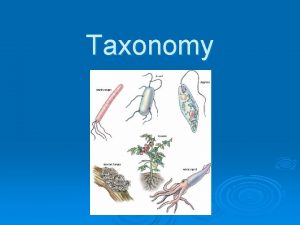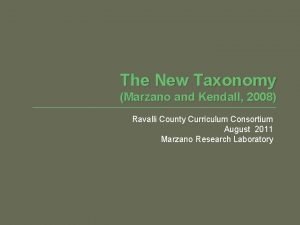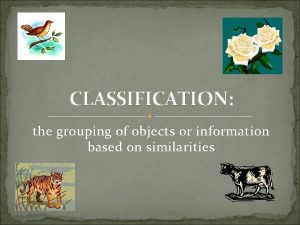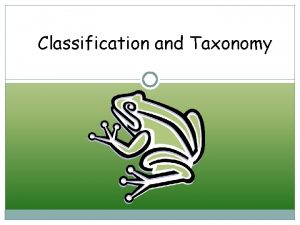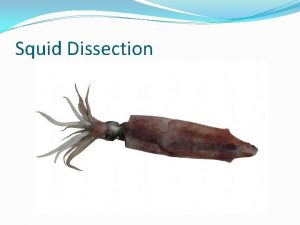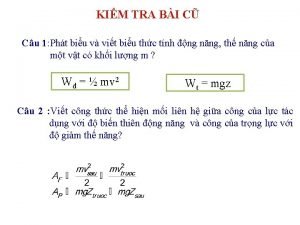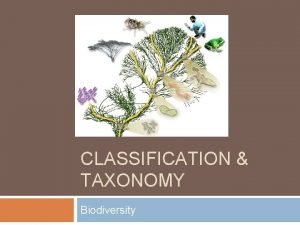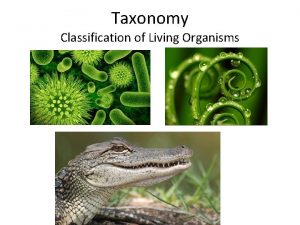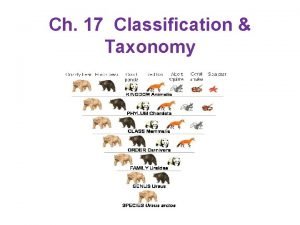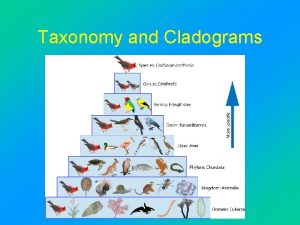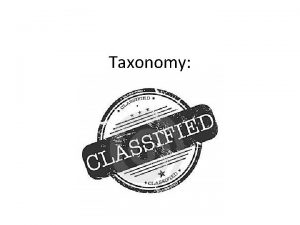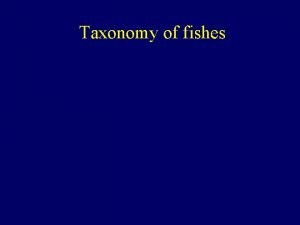Taxonomy Classification Classification the grouping of objects or

Taxonomy

Classification Ø Classification - the grouping of objects or information based on similarities. Ø Used to better understand study the enormous variety of living things.

Taxonomy ØTaxonomy-The branch of biology that groups and names organisms based on studies of their different characteristics.

Classification Ø Based on a system developed by Carolus Linnaeus. Ø He established a system of groups called Taxa (Taxons) Ø He ranked taxa from the largest, most general groups to the smallest, most specific groups.

Classifying Living Organisms Ø Organisms are grouped into taxon l l l l King. Philip. Came. Over For Good. Spaghetti- Kingdom Phylum Class Order Family Genus Species

Classifying Living Organisms Ø At each level, organisms that share the most characteristics are grouped. Ø Species is the most specific. (members of the same species can produce offspring. ) Ø Kingdom - is the most general. Ø NOTE: THE PLANT KINGDOM IS DIVIDED INTO DIVISIONS INSTEAD OF PHYLA.

Linnaeus’s System Carolus Linnaeus’ classification system: in 18 th century Ø Divided organisms into 2 groups: plants & animals Ø Placed plants & animals into groups based on similarities of form (shape, structure) Ø

Linnaeus’s System Ø Has groups within larger groups within still larger groups Ø Uses unique (one-of-a-kind), descriptive Latin names as scientific names for each organism • Bats fly like birds, but have hair and produce milk l Therefore bats are mammals and not birds

Binomial Nomenclature Ø Crawdad, Crayfish, Mudbug is the difference? What Ø Scientists need a universal name for every organism. Ø He proposed a system of naming using 2 names; this system is called Binomial nomenclature

Ø The 2 names for each organism are: l l Genus - always first and capitalized; can be abbreviated to 1 letter. species - second and lowercase ****Both are underlined or italicized*** Ø Humans- Homo sapiens l Homo- Genus sapiens- “Wise”

Domain Archae 2. Eubacteria 3. Eukarya 1.

Six Kingdom Taxonomy System How evolutionary relationships are determined: Today the most generally accepted classification system contains six kingdoms: Ø Archaebacteria Ø Eubacteria Ø Protists Ø Fungi Ø Plants Ø Animals Ø

Six Kingdoms These kingdoms are then broken down into smaller categories. Ø Characteristics that scientists use to classify the relationships of organisms include: Ø l l l structural similarities breeding behavior geographical distribution chromosome comparison biochemistry

Dichotomous Key Ø Dichotomous Key: made of sets of numbered statements; each set deals with 1 trait of the organism; follow the numbered sets until the key reveals the name of the organism.

Classification Models Ø Phylogeny- The evolutionary history of a species. l Also shows evolutionary relationships of species

Cladistics Ø Cladistics: system of classification based on phylogeny (evolutionary history of a species)

Cladogram Ø Cladogram: branching diagram that models the phylogeny of a species, resembles a pedigree or family tree showing proposed ancestry of the species.

Cladogram Example

Ø 1. What five probable ancestors of the modern bird (robin) are shown on the cladogram? Answer to #1 • Archaeopteryx • Velociraptor • Sinornis • Allosaurus • Theropods

Ø 2. Which dinosaur is probably the most recent common ancestor of Velociraptor and Archaeopteryx? Answer to #2: Sinornis

Ø 3. Which traits shown on the cladogram are shared by Archaeopteryx and modern birds? Answer to #3 Light bones, 3 -toed foot, Wishbone, down feathers, and feathers with shaft, veins, and barbs

Phylogenetic Diagram Fan-like model can show time organism became extinct, or the relative number of species in a group (evolutionary history)

Ø 1. How does the fanlike diagram differ from a cladogram? Answer to #1 Cladograms provide phylogenetic relationships among species. Fanlike diagrams communicate the time organisms became extinct or the relative number of species in a group.

Ø 2. To which group are sea stars more closely related, arthropods or jellyfishes? Answer to #2 arthropods

Ø 3. Which group of animals includes the fewest species? Answer to #3 Sea Stars (Echinoderms)

Question Ø As scientists began to learn more about geologic time, they incorporated their findings in their systems of classification. The new system that accounted for an organism’s evolutionary history is called- A. Binomial nomenclature Ø B. Phylogeny Ø C. Taxonomy Ø D. None of the above Ø B. phylogeny

Question Ø What does a fanlike diagram show that a cladogram does not? l l A. B. C. D. Phylogenetic relationships Relative number of species in each group Anatomical features of each species Mode of extinction B. Relative number of species in each group
- Slides: 27

